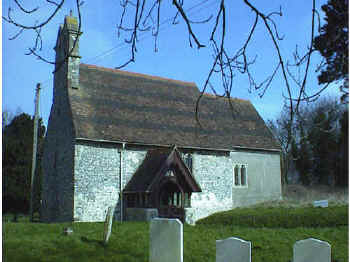| Back ... | Coldred | |
|
|
|
|
| PICTURES The Village Pub Colret House The Village Pond The Village Church The Manor House |
The Carpenters' Arms has live Country & Western music most Saturday evenings from around 9pm to 11.30.
|
|
Voted Kent's best-kept village, Coldred is one of the
highest places in East Kent at nearly 400 feet above sea level.
There are two suggestions as to how the village may have got its name:
The oldest buildings around the village green are those belonging to Chilli Farm, built around 1550 on the foundations of a much earlier building. The farm's name dates from the same period, but there is no record of its origin or meaning. The village pub - the Carpenters' Arms - dates from 1719, according to the mason's mark over the fireplace in the public bar. The present landlady, whose family have run the pub for many years, has not been tempted to modernise it or to open it as a restaurant, like so many other country pubs.
The signpost on the corner shows Shepherdswell 1 mile and Woolage 3 miles to the left, Eythorne 1¾ miles and Elvington 2¾ miles to the right. Towards the camera, across the green, the road leads to the A20 from Dover to Canterbury and London. Colret House
Evidence of similar witch trials can be found on the river Stour at Canterbury, where a "ducking stool" has been preserved behind the Canterbury Weavers.
The church is supposed to have been dedicated to St Pancras by Augustine in AD579. Inside, the church boasts a barrel roof with hammer beams and kingposts. One of the bells, cast before AD1200, rests in the chancel, having been brought down by a storm in 1936. It is one of the oldest bells in Kent. The east window dates from c.1380, although the stained glass was not added until 1873.
The church and manor house were built in the centre of a fortified Saxon camp, believed to date from the 8th century. Most of the remains have been destroyed by centuries of ploughing, but many artefacts have been found dating from the Saxon period. Just outside the village are the remains of the Guilford Colliery, named after the Earl of Guilford on whose land it stood. The Guilford family have owned the Manor since 1790, but they made their home in nearby Waldershare Park. |
||
 The
little church of St Pancras is of mainly Norman construction, with
some remnants of an earlier Saxon building. The foundations are
believed to be Roman.
The
little church of St Pancras is of mainly Norman construction, with
some remnants of an earlier Saxon building. The foundations are
believed to be Roman.